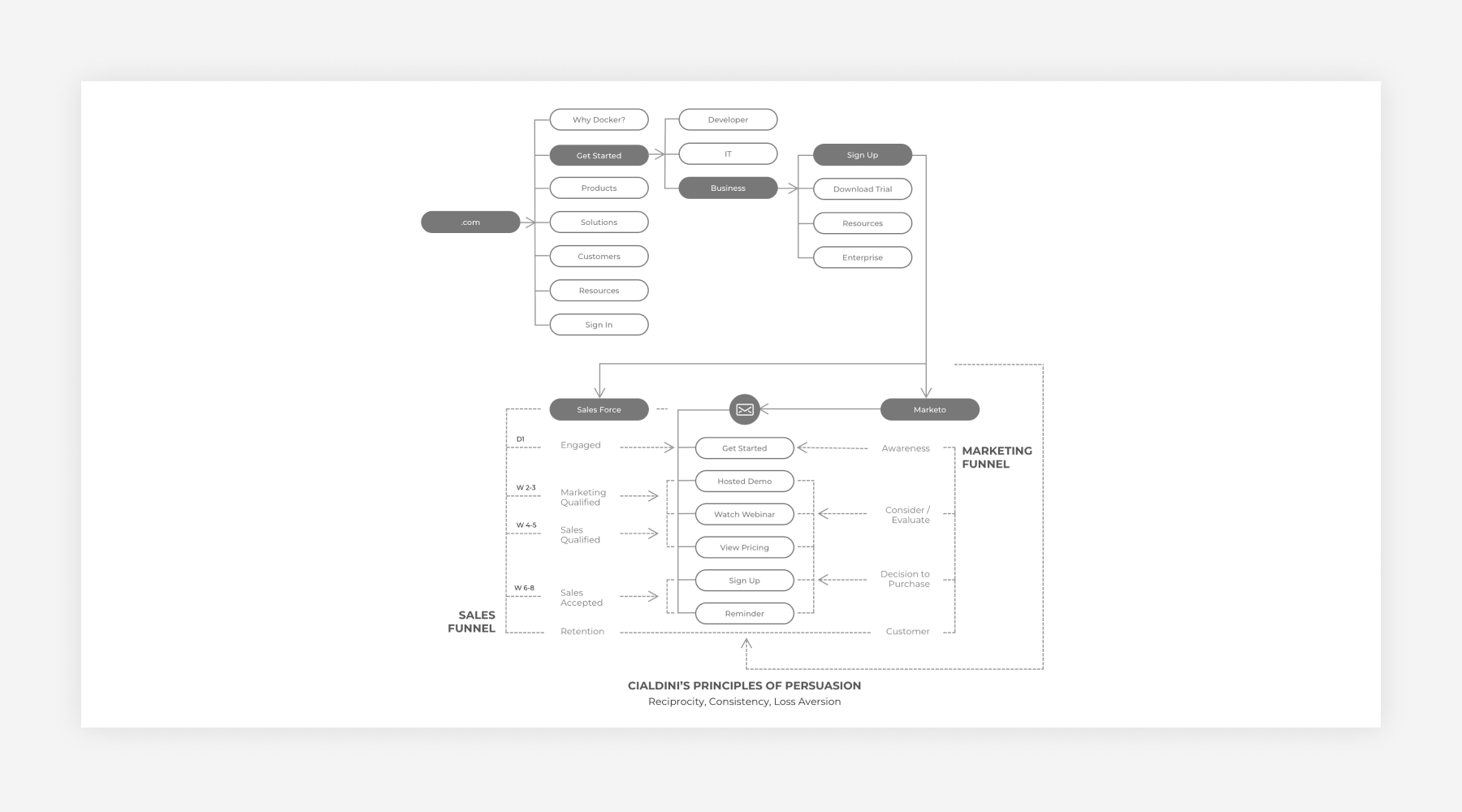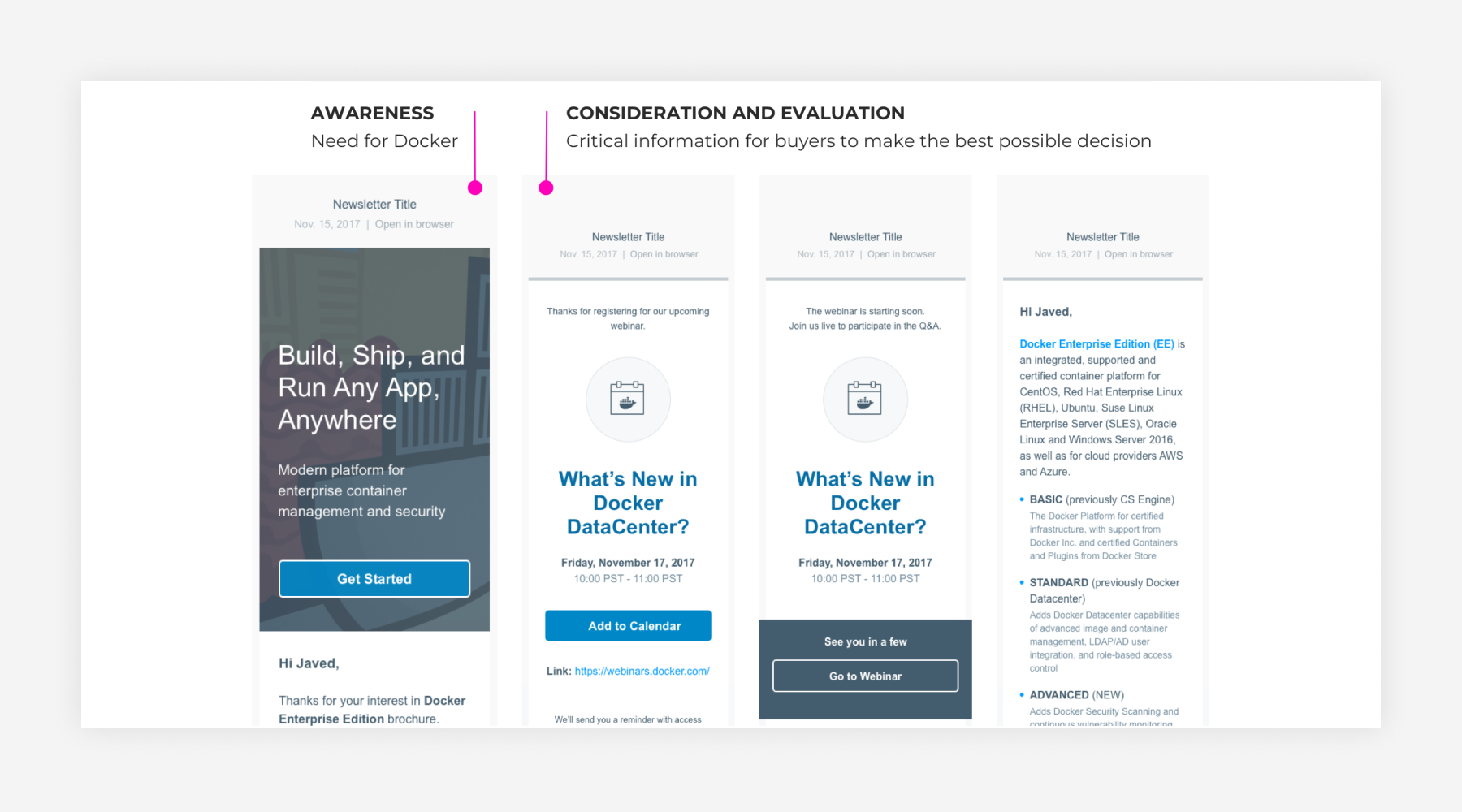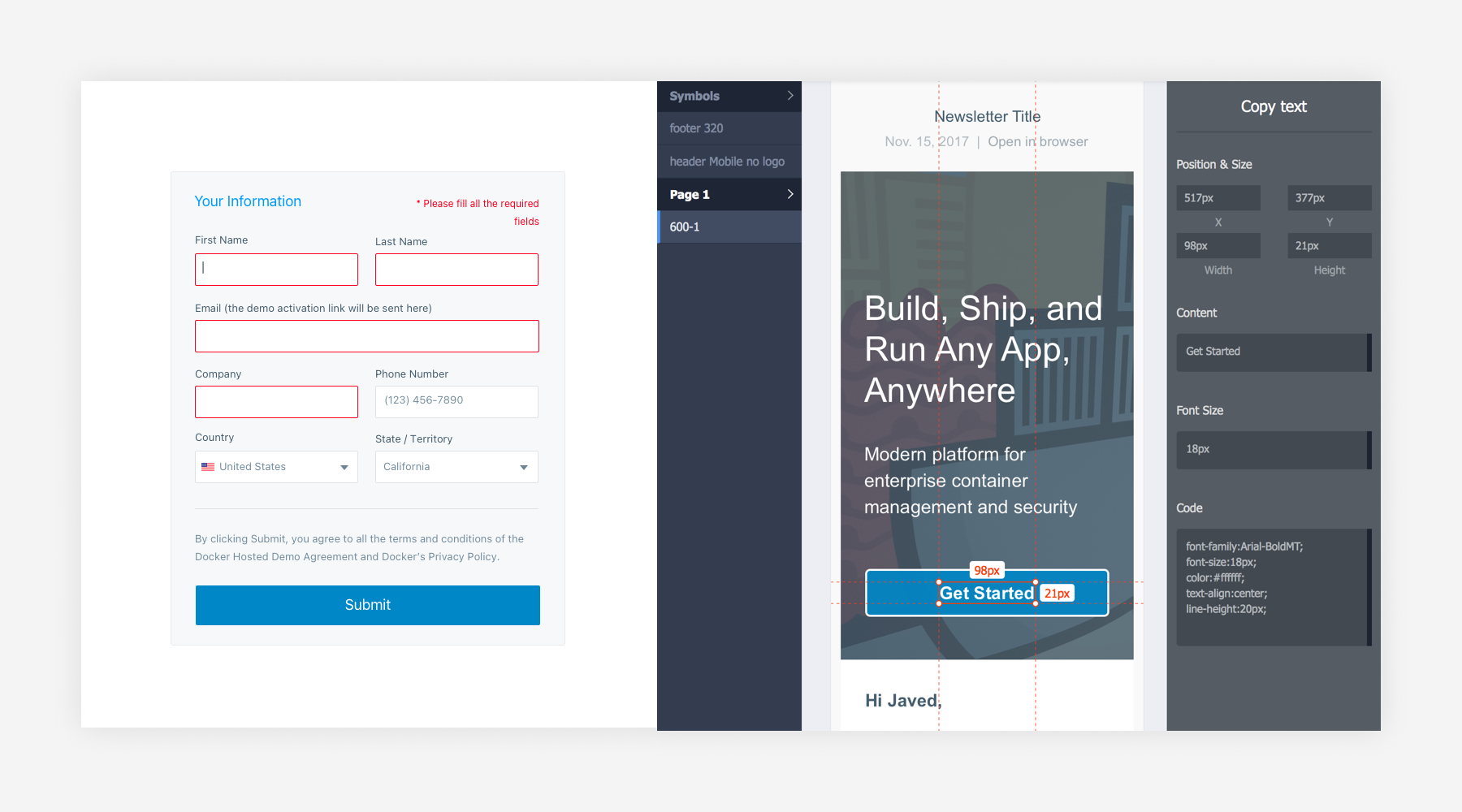{ roi }
Work Impact
2M+
Docker Technical Partners
$M
Revenue boost
GTM
Increased conversion
{ DELIVERABLES }
Brand Communications
{ DELIVERABLES }
Brand Communications
{ DELIVERABLES }
Landing Pages
{ DELIVERABLES }
Landing Pages
{ DELIVERABLES }
Email Campaigns
{ DELIVERABLES }
Email Campaigns
{ DELIVERABLES }
Delightful Enhancements
{ DELIVERABLES }
Delightful Enhancements
{ DELIVERABLES }
Iconography
{ DELIVERABLES }
Iconography
Boosting Revenue with Dynamic Campaigns and Brand Refresh for 2M+ Technical Partners
Boosting Revenue with Dynamic Campaigns and Brand Refresh for 2M+ Technical Partners
At Docker, a pioneering force in cloud infrastructure and container platform technology, I was part of the team critical to our growth phase supporting Docker's $70M Series D funding round. With a thriving community of over 2 million technical partners and 750 enterprise customers, Docker sought to elevate its market presence and streamline its revenue generation processes.
As the Senior Product/Brand Designer, my objective was to redesign the company's brand communications and lead nurturing processes through a comprehensive Marketo strategy, coupled with a brand refresh that would enhance marketing efficiency and brand cohesion.
This initiative would boost Docker's competitive edge in the enterprise container platform market. By integrating Cialdini’s principles of persuasion into our email sales and marketing funnels, we sought to create dynamic campaigns that not only attracted but also retained and converted leads, driving significant revenue growth.
There was a clear need for a more user-centric approach that could deliver targeted, relevant content at each stage of the buyer’s journey. Streamlining these processes would not only enhance engagement but also build stronger relationships with our partners, ultimately driving higher conversion rates and increased revenue.
At Docker, a pioneering force in cloud infrastructure and container platform technology, I was part of the team critical to our growth phase supporting Docker's $70M Series D funding round. With a thriving community of over 2 million technical partners and 750 enterprise customers, Docker sought to elevate its market presence and streamline its revenue generation processes.
As the Senior Product/Brand Designer, my objective was to redesign the company's brand communications and lead nurturing processes through a comprehensive Marketo strategy, coupled with a brand refresh that would enhance marketing efficiency and brand cohesion.
This initiative would boost Docker's competitive edge in the enterprise container platform market. By integrating Cialdini’s principles of persuasion into our email sales and marketing funnels, we sought to create dynamic campaigns that not only attracted but also retained and converted leads, driving significant revenue growth.
There was a clear need for a more user-centric approach that could deliver targeted, relevant content at each stage of the buyer’s journey. Streamlining these processes would not only enhance engagement but also build stronger relationships with our partners, ultimately driving higher conversion rates and increased revenue.
- Brand Consistency As Docker experienced growth, maintaining brand consistency across all communications became increasingly challenging. I observed different teams were creating their own variations of brand elements, resulting in a lack of coherence. This disjointed approach made it difficult to present a unified front to our diverse partner ecosystem, which ranged from individual developers to large enterprise clients. Ensuring that every touchpoint reflected Docker’s core values and visual identity was essential to fostering a strong, recognizable brand.
- Lead Nurturing Effective lead nurturing was critical to Docker’s strategy for driving revenue growth. The goal was to engage potential buyers throughout their journey, from initial awareness to final purchase, ensuring a seamless and supportive experience. Partners were often lost in the sales funnel due to generic communication and inadequate follow-up strategies.
- Brand Consistency As Docker experienced growth, maintaining brand consistency across all communications became increasingly challenging. I observed different teams were creating their own variations of brand elements, resulting in a lack of coherence. This disjointed approach made it difficult to present a unified front to our diverse partner ecosystem, which ranged from individual developers to large enterprise clients. Ensuring that every touchpoint reflected Docker’s core values and visual identity was essential to fostering a strong, recognizable brand.
- Lead Nurturing Effective lead nurturing was critical to Docker’s strategy for driving revenue growth. The goal was to engage potential buyers throughout their journey, from initial awareness to final purchase, ensuring a seamless and supportive experience. Partners were often lost in the sales funnel due to generic communication and inadequate follow-up strategies.

Crafting the Strategy
Crafting the Strategy
To optimize Docker's lead nurturing processes, it was imperative to gain a deep understanding of buyer behavior. I conducted comprehensive research to analyze the critical stages in the buying cycle, from awareness to decision-making.
Leveraging Marketo, I designed a comprehensive funnel strategy that captured leads and guided them through the pipeline. The funnel was structured to address each stage of the buyer’s journey, ensuring that partners received the right information at the right time. This involved creating targeted email campaigns, dedicated landing pages, and automated workflows that nurtured leads from initial contact to conversion.
The Marketo funnel was meticulously mapped to include various touchpoints, such as awareness campaigns, consideration emails, and decision-making support. This strategic approach ensured that our marketing efforts were both efficient and impactful, driving sustained revenue growth.
To optimize Docker's lead nurturing processes, it was imperative to gain a deep understanding of buyer behavior. I conducted comprehensive research to analyze the critical stages in the buying cycle, from awareness to decision-making.
Leveraging Marketo, I designed a comprehensive funnel strategy that captured leads and guided them through the pipeline. The funnel was structured to address each stage of the buyer’s journey, ensuring that partners received the right information at the right time. This involved creating targeted email campaigns, dedicated landing pages, and automated workflows that nurtured leads from initial contact to conversion.
The Marketo funnel was meticulously mapped to include various touchpoints, such as awareness campaigns, consideration emails, and decision-making support. This strategic approach ensured that our marketing efforts were both efficient and impactful, driving sustained revenue growth.
- Understanding Buyer Behavior Analyzed the critical stages in the buying cycle, from awareness to decision-making, to tailor communications effectively.
- Marketo Funnel To capture leads and track lifecycles, driving them into the sales pipeline.
- Automated Campaigns Implemented a multi-phase lead nurturing program that generated interest and moved leads through the sales funnel.
- Understanding Buyer Behavior Analyzed the critical stages in the buying cycle, from awareness to decision-making, to tailor communications effectively.
- Marketo Funnel To capture leads and track lifecycles, driving them into the sales pipeline.
- Automated Campaigns Implemented a multi-phase lead nurturing program that generated interest and moved leads through the sales funnel.

Integrating Cialdini’s Principles of Persuasion
Integrating Cialdini’s Principles of Persuasion
To enhance the effectiveness of our email campaigns, I integrated Cialdini’s principles of persuasion into our marketing funnels. These principles provided a psychological framework to craft messages that resonated deeply with our partners, encouraging them to take desired actions.
By layering the principles into our email and marketing strategies, we were able to create more persuasive and engaging campaigns. This approach not only increased email open and click-through rates but also significantly boosted lead conversion rates, driving higher revenue and fostering stronger partnerships.
To enhance the effectiveness of our email campaigns, I integrated Cialdini’s principles of persuasion into our marketing funnels. These principles provided a psychological framework to craft messages that resonated deeply with our partners, encouraging them to take desired actions.
By layering the principles into our email and marketing strategies, we were able to create more persuasive and engaging campaigns. This approach not only increased email open and click-through rates but also significantly boosted lead conversion rates, driving higher revenue and fostering stronger partnerships.
- Authority and Social Proof Highlighted Docker’s industry leadership and showcased testimonials from reputable partners to reinforce credibility and trust.
- Scarcity and Urgency Introduced time-sensitive offers and limited availability notices to motivate partners to act quickly.
- Consistency and Commitment Personalized follow-up emails built on previous interactions, reinforcing initial commitments and guiding partners toward purchase decisions.
- Authority and Social Proof Highlighted Docker’s industry leadership and showcased testimonials from reputable partners to reinforce credibility and trust.
- Scarcity and Urgency Introduced time-sensitive offers and limited availability notices to motivate partners to act quickly.
- Consistency and Commitment Personalized follow-up emails built on previous interactions, reinforcing initial commitments and guiding partners toward purchase decisions.

Streamlining Email Templates
Streamlining Email Templates
To maximize engagement, I focused on simplifying email designs by adopting a minimalist approach. This involved removing unnecessary elements and ensuring that each communication had a clear purpose and call-to-action (CTA). The minimalist design not only made the emails more visually appealing but also improved readability and user experience across different devices.
By prioritizing essential elements, I reduced clutter and emphasized the key messages, making it easier for partners to understand and act upon the content. The responsive design ensured that emails looked and functioned well on both desktop and mobile devices, catering to the varied preferences and habits of our partner base.
Each email was designed with a singular focus, whether it was driving signups, downloads, or product trials. This targeted approach ensured that the messaging was clear and direct, eliminating confusion and enhancing the likelihood of desired actions.
By clearly defining the objective of each email, we were able to craft more effective CTAs and streamline the partner’s decision-making process. This focus not only improved engagement but also made it easier to measure the success of each campaign, allowing for more precise
To maximize engagement, I focused on simplifying email designs by adopting a minimalist approach. This involved removing unnecessary elements and ensuring that each communication had a clear purpose and call-to-action (CTA). The minimalist design not only made the emails more visually appealing but also improved readability and user experience across different devices.
By prioritizing essential elements, I reduced clutter and emphasized the key messages, making it easier for partners to understand and act upon the content. The responsive design ensured that emails looked and functioned well on both desktop and mobile devices, catering to the varied preferences and habits of our partner base.
Each email was designed with a singular focus, whether it was driving signups, downloads, or product trials. This targeted approach ensured that the messaging was clear and direct, eliminating confusion and enhancing the likelihood of desired actions.
By clearly defining the objective of each email, we were able to craft more effective CTAs and streamline the partner’s decision-making process. This focus not only improved engagement but also made it easier to measure the success of each campaign, allowing for more precise

Email Modularity
Email Modularity
To facilitate efficient campaign management, I implemented an email modularity system. This involved creating reusable components and templates that could be easily customized for different campaigns and purposes. The modular design allowed teams to create and manage campaigns with minimal effort, ensuring consistency and reducing the time spent on email creation.
This approach also enabled rapid scaling of marketing efforts, as new campaigns could be quickly assembled using pre-built modules. The consistency maintained through modularity ensured that all communications adhered to Docker’s brand standards, enhancing brand recognition and trust across all touchpoints.
To facilitate efficient campaign management, I implemented an email modularity system. This involved creating reusable components and templates that could be easily customized for different campaigns and purposes. The modular design allowed teams to create and manage campaigns with minimal effort, ensuring consistency and reducing the time spent on email creation.
This approach also enabled rapid scaling of marketing efforts, as new campaigns could be quickly assembled using pre-built modules. The consistency maintained through modularity ensured that all communications adhered to Docker’s brand standards, enhancing brand recognition and trust across all touchpoints.

Collaboration with Engineering
Collaboration with Engineering
Effective collaboration with the engineering team was crucial to the successful implementation of our design system. Regular sync meetings were established to discuss design specifications, address technical constraints, and gather feedback from developers. This open dialogue ensured that our design vision was accurately translated into code, and any potential challenges were identified and addressed promptly.
We provided developers with detailed design documentation, including annotations and style guides, to facilitate the accurate implementation of components. By maintaining a continuous feedback loop and fostering a culture of mutual respect and understanding, we ensured that our design system was not only visually consistent but also functionally robust and technically feasible.
Effective collaboration with the engineering team was crucial to the successful implementation of our design system. Regular sync meetings were established to discuss design specifications, address technical constraints, and gather feedback from developers. This open dialogue ensured that our design vision was accurately translated into code, and any potential challenges were identified and addressed promptly.
We provided developers with detailed design documentation, including annotations and style guides, to facilitate the accurate implementation of components. By maintaining a continuous feedback loop and fostering a culture of mutual respect and understanding, we ensured that our design system was not only visually consistent but also functionally robust and technically feasible.

Reflections
Reflections
Automated campaigns qualify sales opportunities, allowing Docker to focus more time and effort on meeting customers’ needs. Campaigns used to take days and weeks to develop but is now executed in a few hours. This end-to-end marketing campaign process allows Docker to compete against far larger competitors.
A key component of this project was the standardization of the visual and interaction elements, making it easier to maintain brand consistency across all communications and allowing Docker to scale its outreach efforts efficiently.
Automated campaigns qualify sales opportunities, allowing Docker to focus more time and effort on meeting customers’ needs. Campaigns used to take days and weeks to develop but is now executed in a few hours. This end-to-end marketing campaign process allows Docker to compete against far larger competitors.
A key component of this project was the standardization of the visual and interaction elements, making it easier to maintain brand consistency across all communications and allowing Docker to scale its outreach efforts efficiently.
- Signups and Downloads The new Marketo strategy significantly improved lead conversion rates, driving more signups and downloads for Docker Enterprise Edition.
- Enhanced Brand The revamped brand communications supported Docker’s successful $70M Series D funding round by presenting a consistent and compelling narrative to investors and stakeholders.
- Scalability and Efficiency The system approach allowed Docker to compete against far larger competitors by enabling rapid campaign development and deployment.
- Signups and Downloads The new Marketo strategy significantly improved lead conversion rates, driving more signups and downloads for Docker Enterprise Edition.
- Enhanced Brand The revamped brand communications supported Docker’s successful $70M Series D funding round by presenting a consistent and compelling narrative to investors and stakeholders.
- Scalability and Efficiency The system approach allowed Docker to compete against far larger competitors by enabling rapid campaign development and deployment.
{ let's.connect }
Book a Meeting
{ let's.connect }
Book a
Meeting
{ © JAVED.IO 2024 }














